Leopon
Lioness × Leopard
Mammalian Hybrids
A leopon /LEP-ən/ is the hybrid produced when a lioness mates with a leopard. The hybrid from the reciprocal cross (lion x leopardess) is called a lipard /LIP-erd/.
Many leopard-lion hybrids have been bred in captivity. Best known are those born at Koshien Hanshin Park in Nishinomiya, Japan in the late fifties and early sixties, one of which survived more than twenty years. This is longer than usual for a leopard (maximum recorded life span in captivity 23 years) or a lion, which has an average captive life expectancy of only 13 years.
The staff at Koshien Hanshin decided to breed lion-leopard hybrids because other zoos were focusing on lion-tiger hybrids. They began by raising a lioness and a male leopard together. She was named Sonoko and her leopard mate, Kaneo. Both were born in 1955.
Their first leopon cubs were born in 1959 after 97 days gestation—the gestation period of a hybrid is usually intermediate in length between those of its parents (in leopards gestation lasts 90-105 days, and in lions, 105-110 days). Three more were born in 1962, a male and two females.
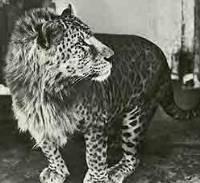 Lioness x Leopard
Lioness x Leopard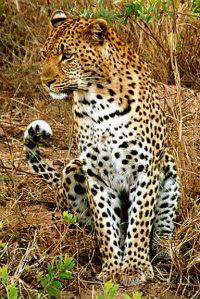 Leopard
Leopard
One of the interesting facts about leopons is that, unlike lions, they're good climbers. They also enjoy water, which often distresses their lioness mothers. Leopons are big animals nearly the size of a lion, with stout bodies, but their legs are shorter, like a leopard’s (Hemmer 1966). They have brown spots, paler than the leopard’s black spots, and tufted tails, like a lion. The base color is pale reddish yellow. Mature males have sparse manes about 8 inches (20 cm) long.
Although the leopard and lion come into contact in sub-Saharan Africa, it is widely believed that a leopon could not occur in a natural state because a leopard would be unable to mate with an unsedated lioness. But many reported hybrids of this type were the result of unplanned crosses in captivity. Doi and Reynolds (1967) say a lioness willingly and regularly lay on her side for a leopard to mount (the pair in question were raised together).
There are, however, anecdotal reports of natural hybrids, known as marozis, from Cameroon, Central African Republic, Uganda, Rwanda, Kenya, and Ethiopia. Apparently, the only solid evidence of hybridization occurring in the wild is a skin (and possible skull) in the British Museum of Natural History, shot in 1931 in Kenya’s Aberdare Mountains (this pelt is described in detail in Note 5 below).
As to the reciprocal cross, Florio (1983) reports a case of a lipard, occurring in Italy. In this particular case there was a large difference in the sizes of the parents. The lion father weighed 550 pounds (250 kg), while the leopard mother weighed a mere 84 pounds (38 kg), that is, he was more than six and a half times her size. Unfortunately for the leopardess, the lion attempted to mate at every opportunity. Another lion-leopardess hybrid was born in Schoenbrunn Zoo, Vienna, in 1951.
A 3-way cross between a leopard, a jaguar and a lion >>.
References:
Antonius (1951b); Doi and Reynolds (1967); Flower (1929a); Gray (1972); Hemmer (1966: figs. 75, 76, 78, 1968c); International Zoo Yearbook (1959, 1960, 1961, 1962); Petzsch (1956); Peters (1978); Pocock (1908a, 1908b, 1913, 1951) (List of Works cited).
Leopon notes:
(1) Stuffed leopons are on display in Japan at the National Science Museum in Tokyo.
(2) According to Jerdon (1874: 174), Arab tradition says the cheetah is a product of this cross (see also Platt 1909).
(3) This hybrid was apparently known even in ancient times, since it is mentioned by Pliny (Natural History, Book VIII, xvii).
 Reginald Innes Pocock
Reginald Innes Pocock(1863-1947)
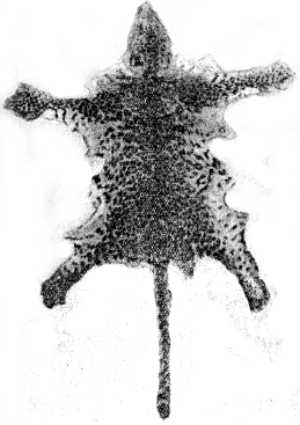 Leopon cub skin described by Pocock.
Leopon cub skin described by Pocock.
(4) In a letter to The Field (Nov. 2nd, 1912), R. I. Pocock gives the following description of the pelt of a leopon now in the British Museum of Natural History. Pocock thanked Walter Samuel Millard, the Honorary Secretary of the Bombay Natural History Society, for sending me a skin of a specimen, which, "according to the testimony of Col. F W Wodehouse, was bred in the gardens at Kolhapur between a male panther i.e. a large leopard and a lioness. There were
(5) Reginald Pocock (1951) describes the skin of a wild-shot leopon: "It is a male, measuring approximately: head and body 5 ft. 10 1/2 in., tail, without terminal hairs of the tuft, 2 ft. 9 in., making a total of about 8 ft. 8 in. This is of course small for adult East African lions, of which the dressed skins may
Leopons in a Japanese museum:
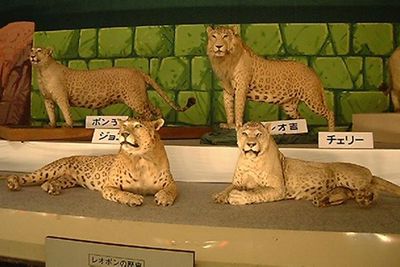 Image: Wikipedia, TRJN
Image: Wikipedia, TRJNA list of cat crosses
The following is a list of reported cat crosses. Some of these crosses are much better documented than others (as indicated by the reliability arrow). Indeed, some might seem completely impossible. But all have been reported at least once. The links below are to separate articles. Additional crosses, not listed here, are covered on the cat hybrids page.
|
|
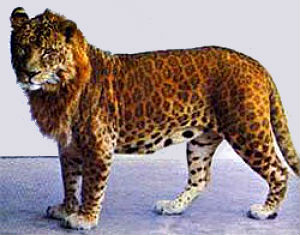 Lioness × Leopard
Lioness × Leopard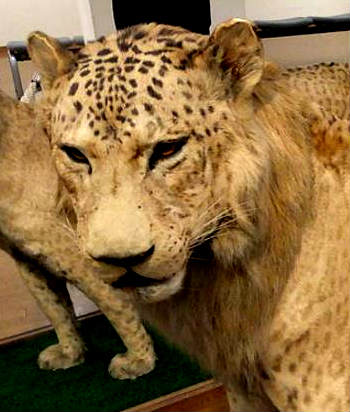 Close-up of face (male).
Close-up of face (male).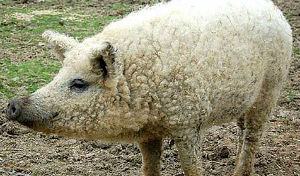 Sheep-pig hybrids?
Sheep-pig hybrids?